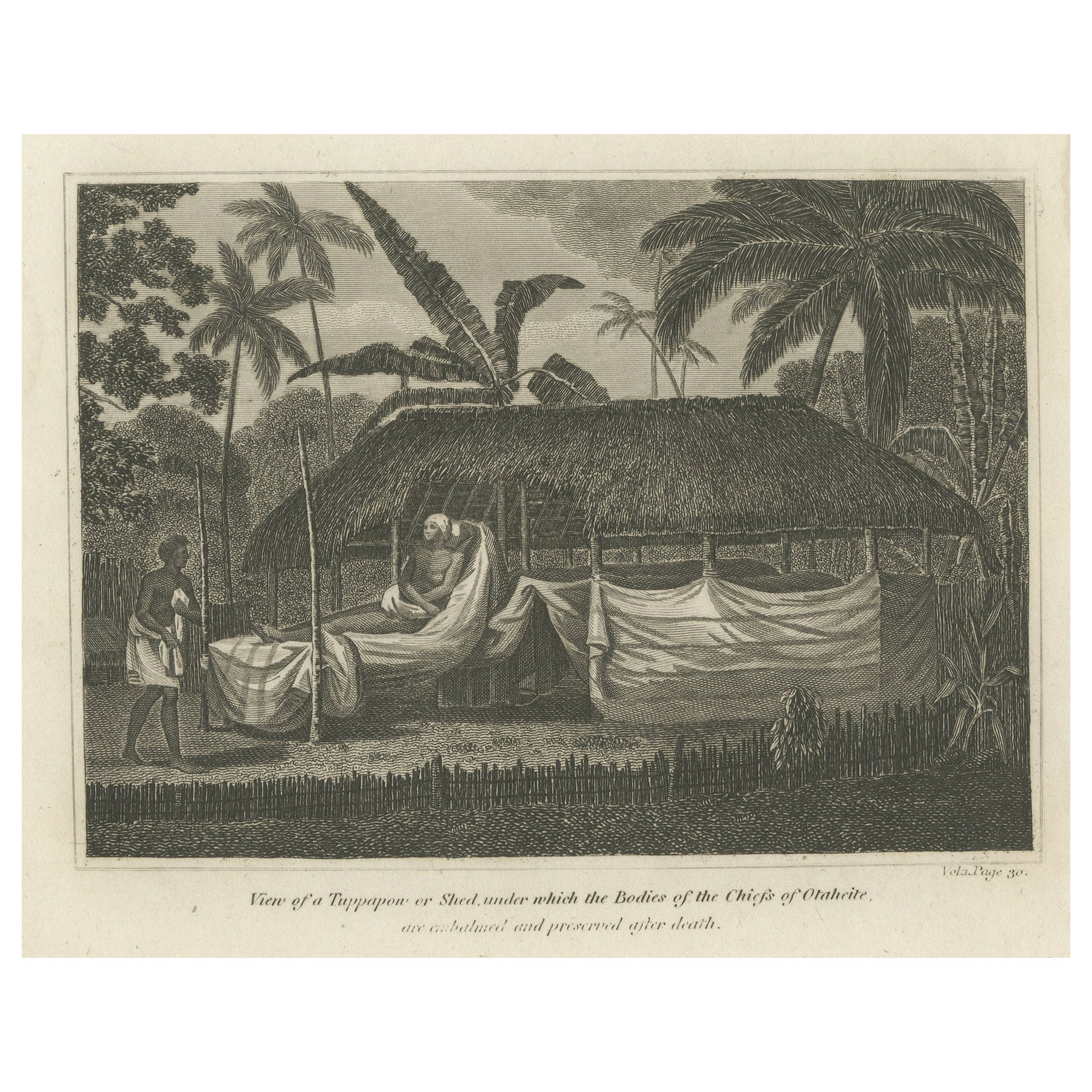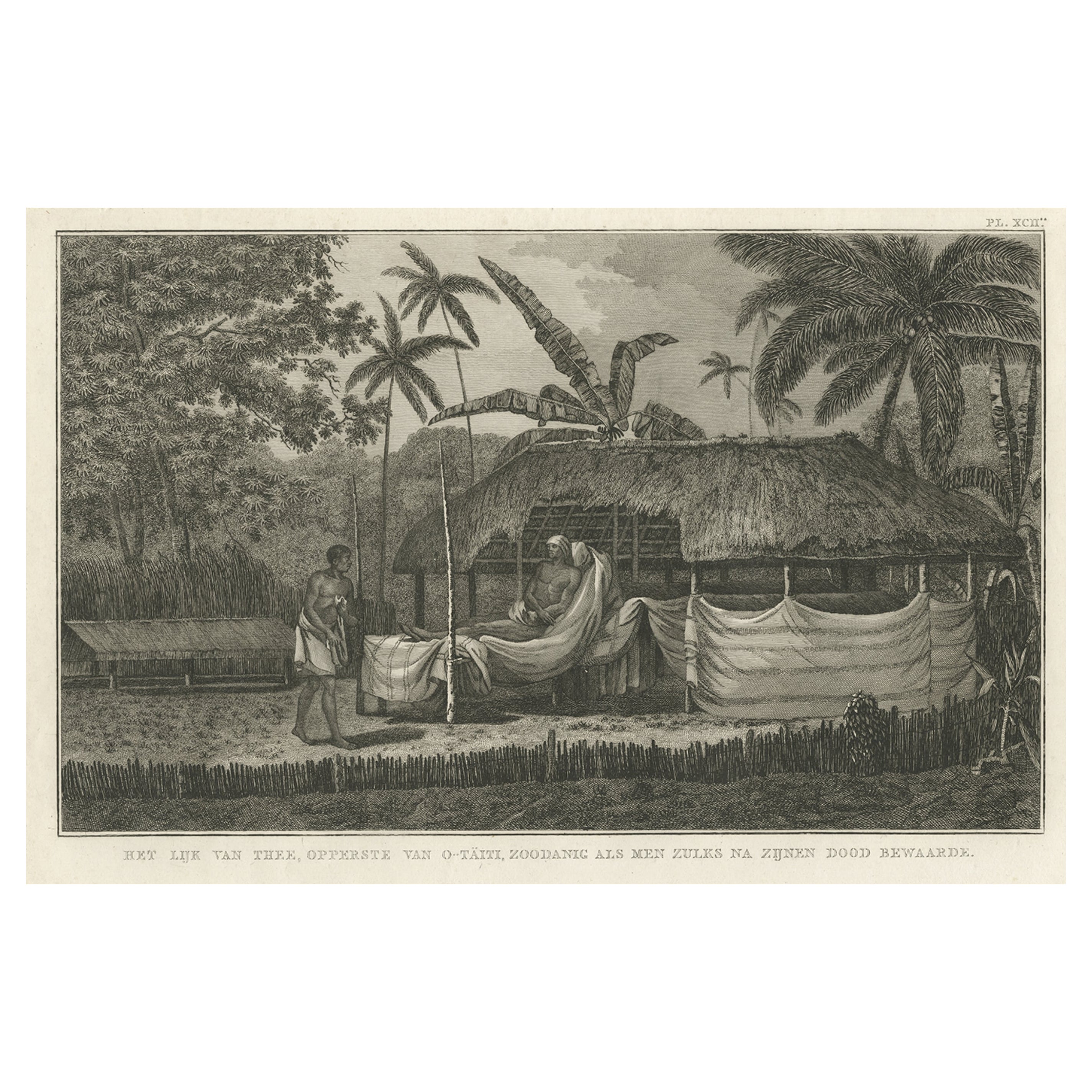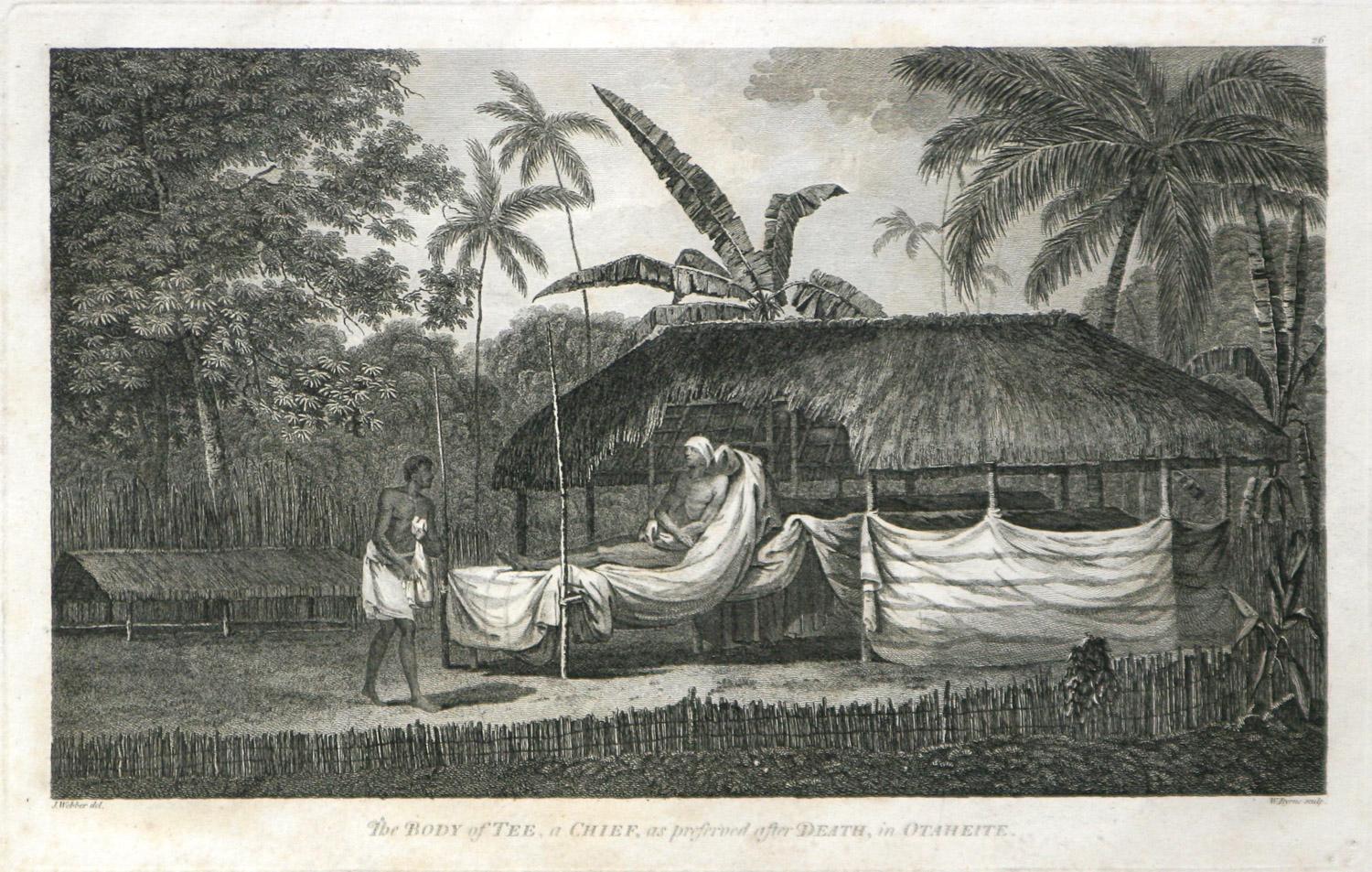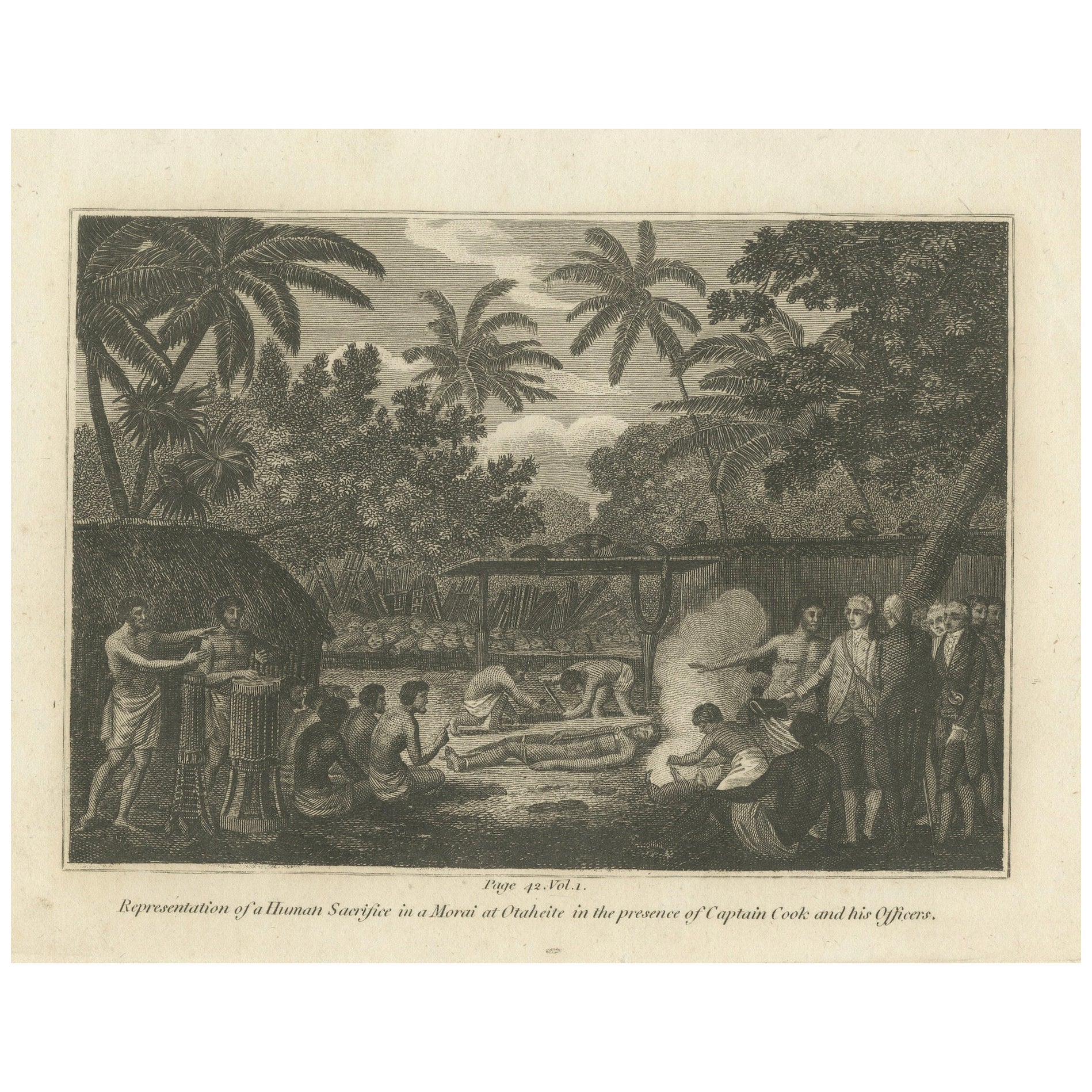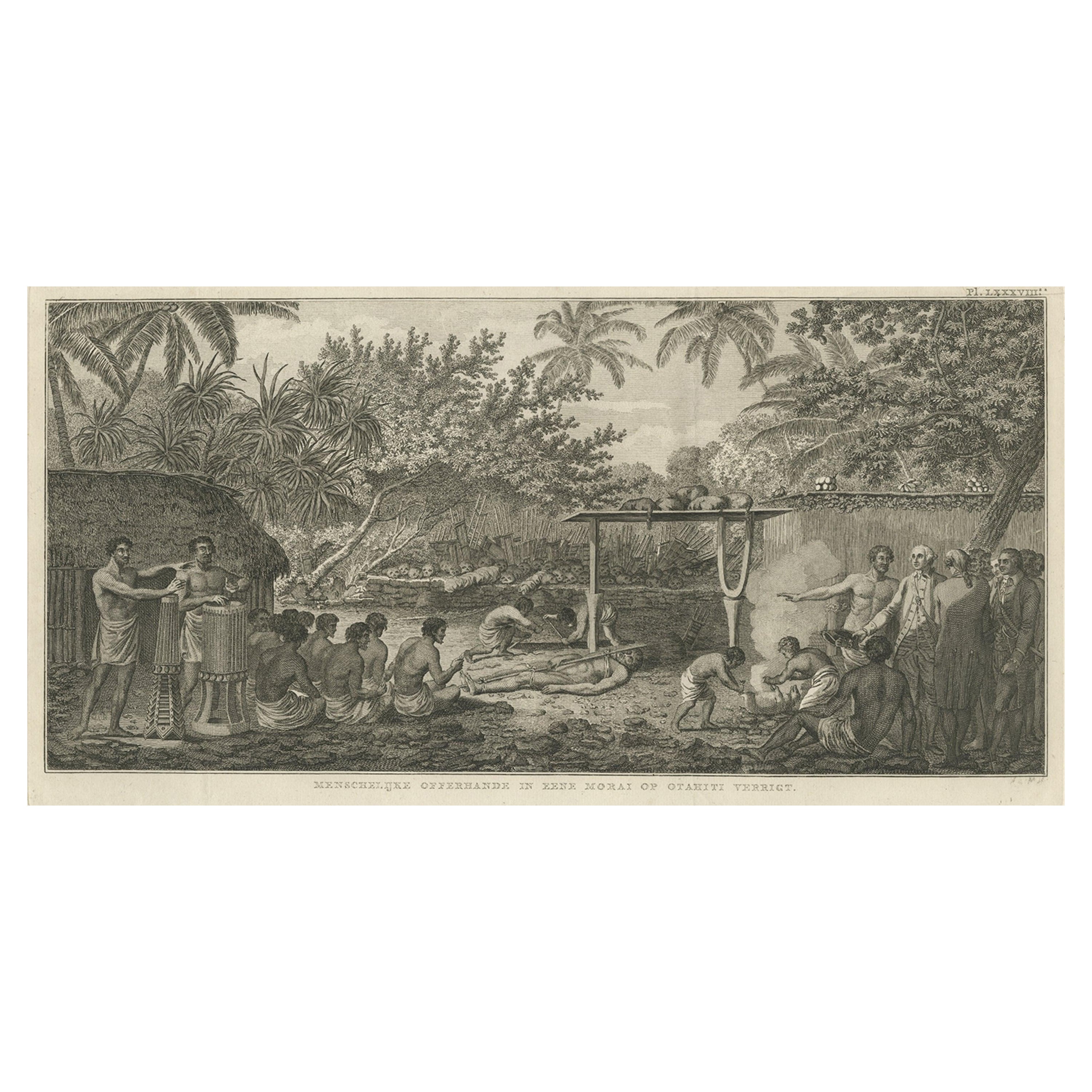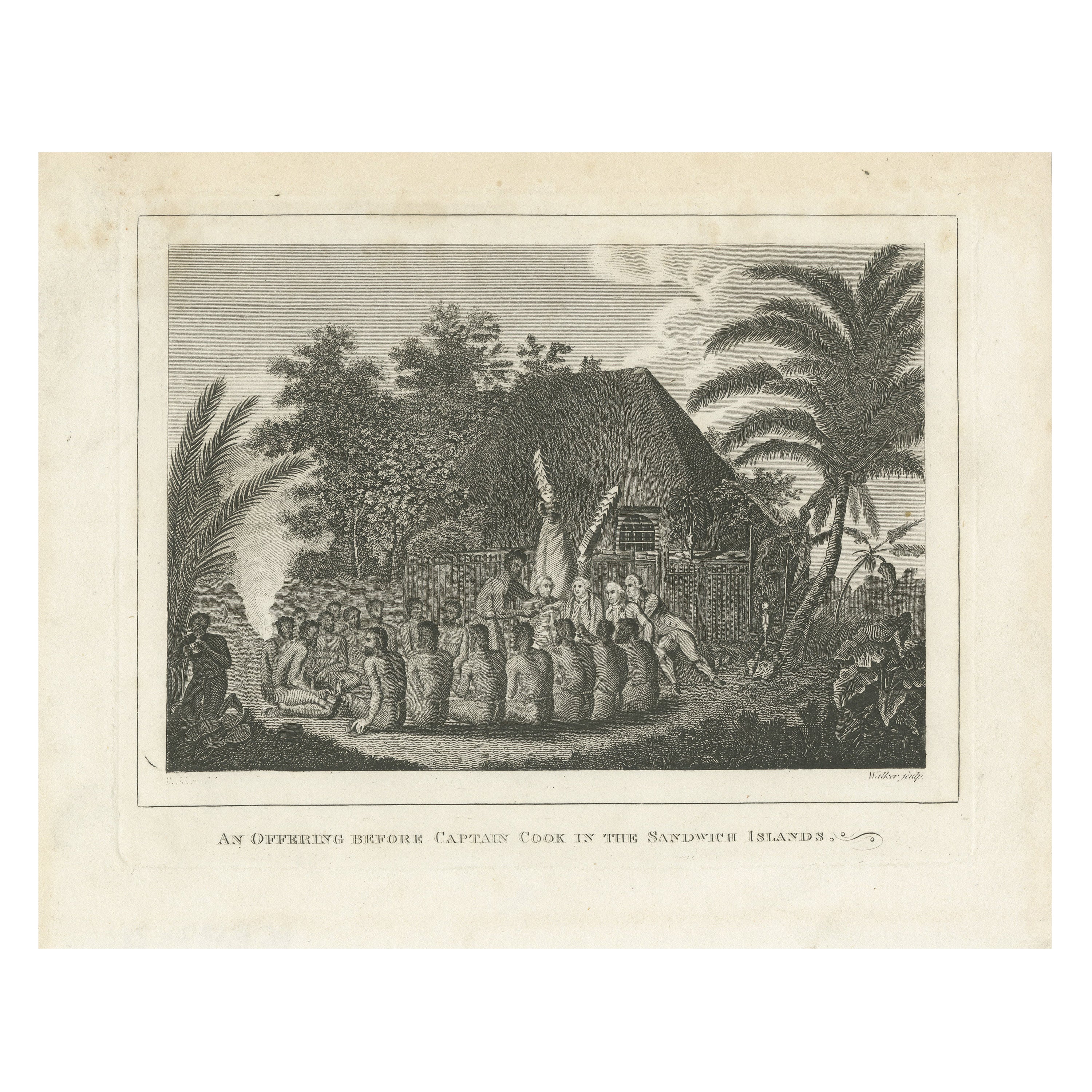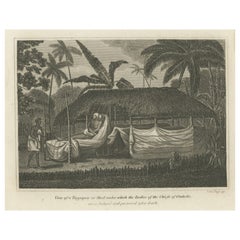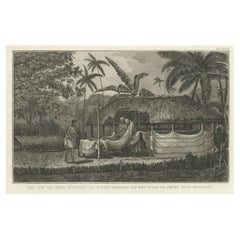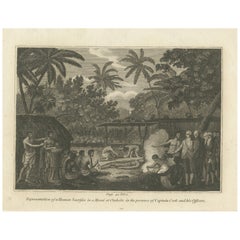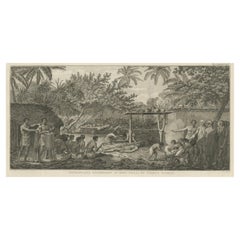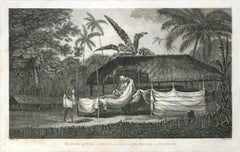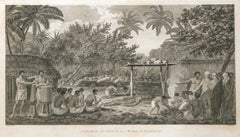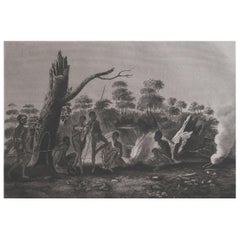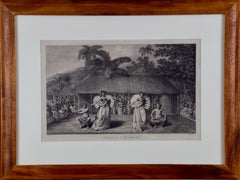Items Similar to Tee's Eternal Rest: The Embalmed Chief of Otaheite or Tahiti, circa 1800
Want more images or videos?
Request additional images or videos from the seller
1 of 6
Tee's Eternal Rest: The Embalmed Chief of Otaheite or Tahiti, circa 1800
$229.86
$287.3220% Off
£169.56
£211.9420% Off
€192
€24020% Off
CA$318.48
CA$398.1020% Off
A$345.60
A$43220% Off
CHF 183.14
CHF 228.9220% Off
MX$4,238.60
MX$5,298.2420% Off
NOK 2,266.30
NOK 2,832.8820% Off
SEK 2,141.54
SEK 2,676.9220% Off
DKK 1,462.04
DKK 1,827.5520% Off
About the Item
Title: "Tee's Eternal Rest: The Embalmed Chief of Otaheite"
Description: This engraving, after a drawing by John Webber, depicts the preserved body of Tee, a chief from Otaheite (Tahiti), following his death. The artwork originates from an account of Captain James Cook's third voyage and showcases the practice of preserving the dead in Tahitian culture. The scene takes place in Matavai Bay, a significant location during the era of exploration, already famed through earlier visits and the engravings of Sydney Parkinson and William Hodges.
In the foreground, we see the tupapau, an elevated platform, which holds the body of Chief Tee. His body has been embalmed, a process that has successfully maintained its condition for over four months despite the humid climate of Tahiti. The engraving reflects the respect and honor accorded to the deceased chief, with his body carefully shrouded, echoing the practices of European art and recalling classical themes such as depicted in Nicolas Poussin's "The Death of Germanicus."
The image captures a tranquil and solemn moment within a lush tropical landscape, characterized by the thatched structures of the Tahitian people and the rich vegetation of palm trees. An attendant figure is seen by the side of the platform, reinforcing the sense of ongoing care and respect for the departed. John Webber's work, while documenting the cultural practices of the Pacific peoples encountered by Cook, is also steeped in the artistic conventions of his European heritage.
- Dimensions:Height: 8.27 in (21 cm)Width: 10.63 in (27 cm)Depth: 0 in (0.02 mm)
- Materials and Techniques:Paper,Engraved
- Period:
- Date of Manufacture:circa 1817
- Condition:Good. Overal light foxing and some soiling and offset. Image itself undisturbed and sharply detailed. Aged paper with typically warm, yellowish-brown hue, mostly around the edges. Please study the images carefully.
- Seller Location:Langweer, NL
- Reference Number:Seller: BG-13597-571stDibs: LU3054337936072
About the Seller
5.0
Recognized Seller
These prestigious sellers are industry leaders and represent the highest echelon for item quality and design.
Platinum Seller
Premium sellers with a 4.7+ rating and 24-hour response times
Established in 2009
1stDibs seller since 2017
2,622 sales on 1stDibs
Typical response time: <1 hour
- ShippingRetrieving quote...Shipping from: Langweer, Netherlands
- Return Policy
Authenticity Guarantee
In the unlikely event there’s an issue with an item’s authenticity, contact us within 1 year for a full refund. DetailsMoney-Back Guarantee
If your item is not as described, is damaged in transit, or does not arrive, contact us within 7 days for a full refund. Details24-Hour Cancellation
You have a 24-hour grace period in which to reconsider your purchase, with no questions asked.Vetted Professional Sellers
Our world-class sellers must adhere to strict standards for service and quality, maintaining the integrity of our listings.Price-Match Guarantee
If you find that a seller listed the same item for a lower price elsewhere, we’ll match it.Trusted Global Delivery
Our best-in-class carrier network provides specialized shipping options worldwide, including custom delivery.More From This Seller
View AllMourning the Chief: Engraving of The Morai at Otaheite, now called Tahiti, 1817
Located in Langweer, NL
An original historical engraving from G. Alexander Cooke's "Geography," published in 1817. The engraving is titled "View of a Tuppapon or Shed under which the Bodies of the Chiefs of...
Category
Antique 1810s Prints
Materials
Paper
$469 Sale Price
20% Off
Free Shipping
Antique Engraving of the Dead Chief of Tahiti Island in the Pacific, 1803
By James Cook
Located in Langweer, NL
Antique print titled 'Het Lijk van Thee, Opperste van O-Tahiti, zoodanig als men zulks na zijnen dood bewaarde'. Antique print depicting the remnents of Thee, Chief of Tahiti. Origin...
Category
Antique 19th Century Prints
Materials
Paper
$277 Sale Price
20% Off
Ceremonial Rites: A Human Sacrifice in Otaheite (Tahiti), 1801
Located in Langweer, NL
The title for the provided engraving could be "Ceremonial Rites: A Human Sacrifice in Otaheite," capturing the gravity of the depicted event. This print likely illustrates a solemn a...
Category
Antique Early 1800s Prints
Materials
Paper
Human Sacrifice in a Morai, Tahiti – Cook Voyage Engraving c.1795
Located in Langweer, NL
Menschelijke Offerhande in eene Morai of Otahiti verrigt – Human Sacrifice in Tahiti c.1795
This antique print depicts a dramatic and solemn scene of a human sacrifice performed in ...
Category
Antique Early 1800s European Prints
Materials
Paper
$708 Sale Price
20% Off
Free Shipping
The Ceremonial Offering to Captain Cook in Hawaii, Engraved in 1778
Located in Langweer, NL
Title: "The Ceremonial Offering to Captain Cook in Hawaii, 1778"
This detailed antique engraving, titled "An Offering Before Captain Cook in the Sandwich Islands," captures a significant historical encounter from Captain James Cook's voyages. The artwork, based on a drawing by John Webber, who accompanied Cook, was skillfully translated into print by the combined talents of Samuel Middiman for the landscape and John Hall for the figures. Created around 1778, this scene illustrates a moment where indigenous Hawaiian men present offerings of suckling pigs to Captain Cook and his European companions. A towering figure wearing an imposing mask stands sentinel behind the Europeans, symbolizing the cultural richness and ceremonial traditions of the Hawaiian people. The scene is framed by native palms and lush tropical vegetation, with a typical steep-roofed thatched building enclosed by a fence in the background, hinting at the architectural styles of the era. This print, marked by 'Walker sculp', offers a poignant visual narrative of cultural exchange in the age of exploration.
Category
Antique Late 18th Century Prints
Materials
Paper
$469 Sale Price
20% Off
Free Shipping
Old Print of a Building Protecting the Warriors of Chief Palu, Tonga Tabu, 1836
Located in Langweer, NL
Antique print titled 'Anischt eines Schoppens der die Kriegspiroguen des Häuptlings Palu beschirmt'.
Old print of a building protecting the warriors of Chief Palu, Tonga Tabu. This print originates from 'Entdeckungs, Reise der Franzosischen Corvette Astrolabe Unternomen auf Befehl Konig Karls...
Category
Antique 1830s Prints
Materials
Paper
$344 Sale Price
20% Off
You May Also Like
The Body of Tee, a Chief, as preferred after Death, in Otaheite (Tahiti)
By John Webber
Located in Paonia, CO
The Body of Tee a chief as preferred after Death in Otaheite (Tahiti) is from the 1784 First Edition Atlas Accompanying Capt. James Cook and King; Third and Final Voyage of Capt...
Category
1870s Realist Figurative Prints
Materials
Engraving
A Human Sacrifice, in a Morai, in Otaheite (Tahiti) 1784 James Cook Final Voyage
By John Webber
Located in Paonia, CO
A Human Sacrifice in a Morai in Otaheite (Tahiti) 1784 by John Webber is from the First Edition Atlas Accompanying Capt. James Cook and King; Third and Final Voyage of Captain...
Category
1780s Realist Figurative Prints
Materials
Engraving
Original Antique Ethnographical Print, Figures, New South Wales, Australia, 1809
Located in St Annes, Lancashire
Wonderful ethnographical print.
A copper-plate engraving after Lesieur
Published by Sherwood, Neely & Jones. Dated 1809
Unframed.
Category
Antique Early 1800s English Folk Art Prints
Materials
Paper
"A Dance in Otaheite" (Tahiti), Engraving from Captain Cook's 3rd Voyage
By John Webber
Located in Alamo, CA
"A Dance in Otaheite" (Tahiti) is an engraving created by William Sharp (1749-1824), from a drawing by John Webber (1752-1793), who was the artist on Captain James Cook's 3rd and final voyage of discovery. It is a plate in the atlas of "A Voyage to the Pacific Ocean Undertaken by the Command of His Majesty, for Making Discoveries in the Northern Hemisphere", the official British Admirality sanctioned journal published upon completion of the voyage in London in 1784 by Strahan & Cadell.
Two women and two men wearing ceremonial costumes, performing a dance outdoors standing on a mat. Three men are playing the drums in the background, in front of a thatched roof building. An audience of men are sitting on both sides of the stage. By the time Webber arrived in Tahiti, 'south sea' imagery had become familiar. Webber gave concentrated attention to dance. He had the opportunity to distinguish the Tahitian dance from the more formalized dancing of Tonga. Whereas they seem to have called to mind the more formal dances of antiquity, the Tahitian dancing aroused memories of peasant and folk dancing.
This engraving is professionally framed in Koa wood. Koa wood is legendary in Hawaii. Not only is this amazing wood native to Hawaii, but it is known for the deep rich colors and varied grain pattern. Koa has an honored heritage in Hawaii and is highly revered and sacred. The word “koa” means “warrior” in Hawaiian. The warriors of King Kamehameha the Great, created canoes and weapons from a wood plentiful on the Big Island of Hawaii. This wood became synonymous with the warriors themselves, and it became known as koa.
The print is in excellent condition.
There are three other engravings listed from the official journal of Captain Cook's 3rd voyage available that are presented in identical Koa wood frames and double mats (LU117324682432, LU117324684052, LU117324684062). They would make a wonderful grouping for a display of 2, 3 or 4 prints. A discount is available for a grouping depending on the number of items included.
Hawaii was discovered by Captain Cook during this voyage. Hawaii was originally called The Sandwich Islands in honor of The Earl of Sandwich...
Category
1780s Realist Landscape Prints
Materials
Engraving
Indigenous Costumes - Original Lithograph - 19th Century
Located in Roma, IT
Indigenous Costumes is an original lithograph realized by an anonymous engraver of the 19th Century.
Printed as part of the series "France Pittoresque", as indicated at the top cent...
Category
19th Century Figurative Prints
Materials
Lithograph
Caribbean Indigenous People / Orinoco, America, mid 19th century lithograph.
Located in Melbourne, Victoria
'Famiglia di Karaibi' / 'Tartarnughe deponenti le uova alle sponde dell' Orenoko''
Italian lithograph, c1841. Originally from 'Galleria universale di tutti i popoli del mondo' by Gi...
Category
Mid-19th Century Naturalistic Figurative Prints
Materials
Lithograph
More Ways To Browse
Travertine Elephant
Trumpet Leg
Tv Chest
Used Wooden Plant Stand
Vallauris Jardiniere
Victorian Coach
Victorian Staffordshire Figures
Victorian Wreath
Vintage African Nude
Vintage Brown Teddy Bear
Vintage Ceramic Angels
Vintage Christmas Carolers
Vintage Conch Shell
Vintage Day Of The Dead
Vintage Erasers
Vintage Harley Davidson Motorcycles
Vintage Match Striker
Vintage Scaffold
